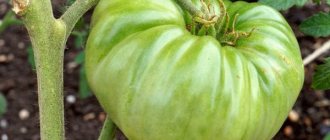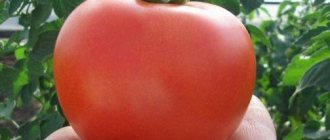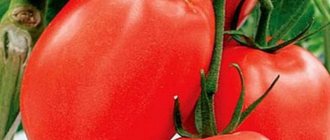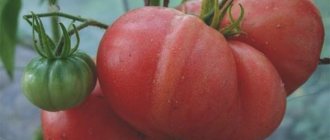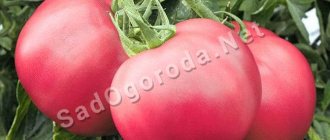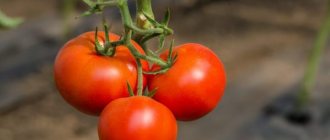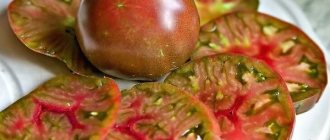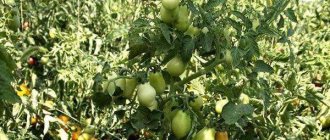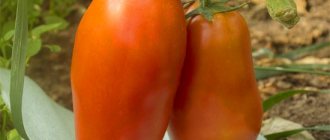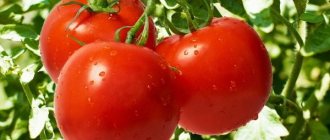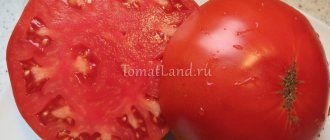Home / Garden / Tomatoes
Back to
Published: 09.07.2018
Reading time: 3 minutes
0
339
Among the numerous tomato hybrids created by domestic scientists and amateur breeders, large seed companies abroad, there are those that have already become a legend and give amazing yields year after year. In our country, the top list includes the Yubileiny Tarasenko tomato.
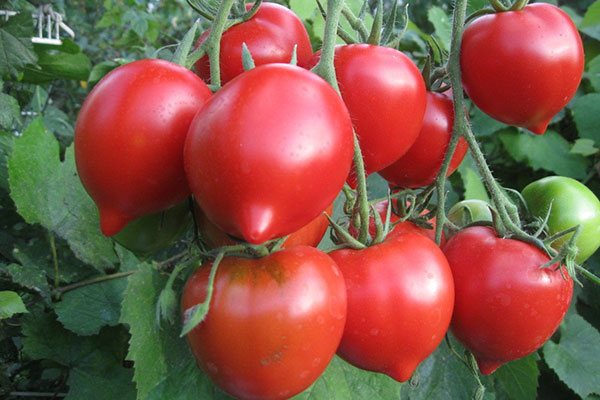
The name, as you understand, was given to the hybrid variety on behalf of its creator Feodosiy Makarovich Tarasenko, a national breeder, a physics teacher by profession. For his 75th birthday, this "maestro of tomato selection" has released a whole collection of new products, among which was Yubileiny Tarasenko, bred on the basis of the best Mexican variety San Marzano.
Unlike its predecessor, which is easily affected by phytophores and other fungal diseases, the Yubileiny Tarasenko tomato variety is completely resistant to them.
Have questions? Ask and get useful advice from professional gardeners and experienced summer residents. Ask a question >>
- 1 Collection of tomatoes Tarasenko
- 2 Characteristics of the bush and the subtleties of care
- 3 Description of fruits
- 4 Agrotechnics of tomatoes Tarasenko
Description of the tomato variety Yubileiny Tarasenko: characteristics, growing region
Feodosiy Makarovich Tarasenko lived and worked in the Sumy region. He created many dozen varieties and hybrids of tomatoes, including the legendary Hybrid-2, Gift to Polesia, Legend, etc. The breeder was not a professional vegetable grower, he worked as a physics teacher at school. Jubilee Tarasenko is a variety that he created for his 75th birthday more than thirty years ago. In addition to breeding new varieties, F.M. Tarasenko conducted a great educational work, described in detail the technology of growing his largely unusual tomatoes.
For some unknown reason, the varieties created by the Ukrainian amateur are not registered in the State Register of the Russian Federation, although they are well known to our gardeners and are loved by them. Because of this, confusion with names often happens. So, many firms sell the seeds of the Jubilee, but their descriptions differ. Even the shape of this tomato variety is described as both round and plum. Although it turns out that even in the old photos presented by the author, there are both tomatoes without a spout, and with it, but they are all rounded.
Infographics: a short description of the Yubileiny Tarasenko tomato variety
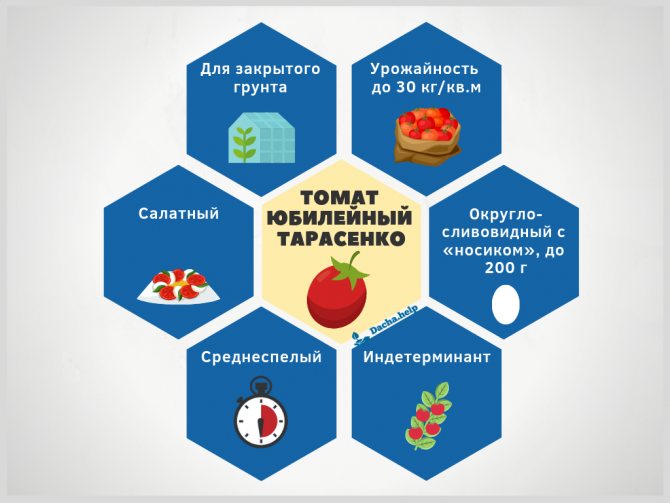

Brief description of the variety Yubileiny Tarasenko
All the tomatoes bred by F.M.Tarasenko differ significantly from the ones we are used to in that they grow in the form of a liana-shaped bush at least two meters high, and the tomatoes are collected in very large fan brushes. They contain several dozen fruits of average or above average size, as a result of which each cluster can weigh 3-4 kg. As a rule, large leaves resemble potato leaves.
All this applies to Jubilee Tarasenko. It is grown in all regions, both in greenhouses and in unprotected soil, but not everywhere the yield is equally record. Nevertheless, even in cold areas, without shelter on the bushes, it manages to tie and ripen 2-3 huge brushes, as a result of which quite decent harvests are collected. And in greenhouses or in the south, at least five brushes are formed, and up to 20 kg of tomatoes are harvested from one plant.Of course, without qualified care, this figure is lower, sometimes by half.
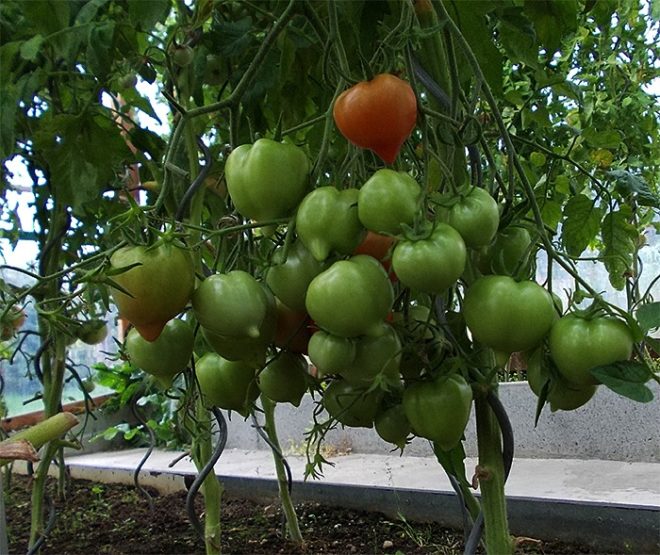

This is why this variety is called a liana: the stems twine around obstacles, while carrying huge heavy brushes on them.
Jubilee Tarasenko is a mid-season variety; it takes about four months from sowing seeds to ripening the first tomatoes. The fruits are beautiful, rounded, often with a sharp nose, red-orange in color. They are dense, which allows you to transport crops over any distance. The taste is full-bodied, typically "tomato". The size of the fruits within the cluster is not uniform: there are small ones suitable for whole-fruit canning, and large ones that are suitable for salads. On average, the weight of the fruits ranges from 70 to 200 g. At the same time, the ripening of the fruits proceeds unevenly: the first to ripen are those that are in the middle of the brush.
In total, fruiting is stretched for about a month and a half. In cold regions, it is recommended to pick tomatoes in a state of blanche ripeness: they ripen well in room conditions. Tomatoes can be stored for up to one and a half months. The taste of fresh tomatoes is rated as good or excellent, they are suitable for any method of consumption, only a little juice is obtained from them.
The variety has a high resistance to diseases, easily tolerates cold snaps and heat. A powerful root system allows the plant to easily survive temporary droughts and relative lack of nutrition. Seeds harvested from their own harvest are suitable for sowing next year: the opinion that Jubilee is a hybrid of the first generation is erroneous.
Video: tomato seeds Yubileiny Tarasenko
Transfer to the ground
At the time of transplanting, each plant must have at least 8 leaves and a flower ovary is possible.
Seedlings must first be hardened. This procedure is best done in 2 weeks, gradually lowering the temperature.
The beds are prepared in advance, treated with a manganese solution and dug up. The holes are staggered, the distance is from 70 cm, the depth is not less than 20 cm.
The plant is deepened to the first leaves, sprinkled with soil and lightly tamped.
If the shoot is too long, it is necessary to plant at an angle. After planting, the tomatoes are watered with warm water, then they are not moistened for a week to adapt.
Once every 14 days, the culture is fertilized and weeds are removed.
Advantages and disadvantages, differences from other varieties
When they try to look for flaws in the Yubileiny Tarasenko tomato, the only thing that comes to mind is that it is not very easy to care for it. The peculiarities of the shape of the bush necessitate careful care both at the seedling stage and in the garden: the correct formation of the plant and the systematic tying of the stems are required. Otherwise, the characteristic of the variety is only delightful. The main advantages of the Jubilee are:
- the highest yield per bush;
- increased disease resistance;
- plant resistance to changes in weather conditions;
- excellent transportability and duration of the preservation of the crop;
- spectacular appearance of the fruit;
- versatility of using tomatoes.
A feature of the variety is precisely the very high yield from the bush. However, if we take into account the sparseness of plantings, when recalculated per square meter, the numbers turn out to be somewhat less record, although also very good: after all, no more than two plants are planted per 1 m2 of area. It is possible to compare the characteristics of Jubilee Tarasenko only with similar tomatoes that are considered liana-shaped. In addition to most of the varieties of this author, with a certain degree of convention, all variations of the famous De Barao variety are also referred to as such.
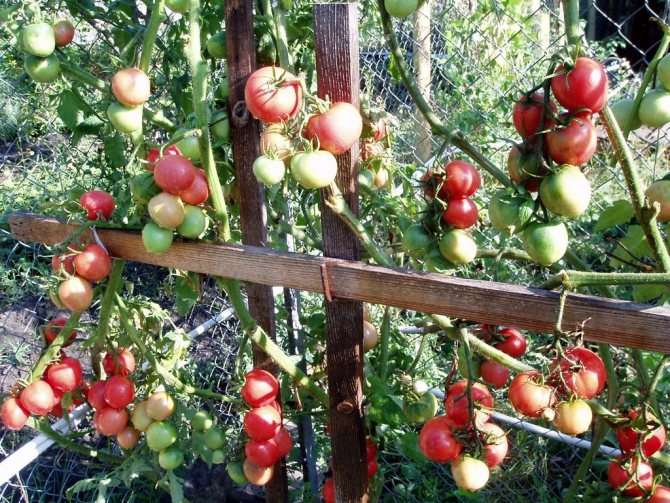

Tomatoes of the De barao series are in many ways similar to those of Tarasenko
It is worth saying that any tomato from this list is good in its own way, they differ only in nuances.All show a very high yield in terms of not a plant, all bear fruit in giant clusters, tomatoes are dense and beautiful, have universal application. Jubilee Tarasenko should not be singled out in this series as the best, but he is undoubtedly one of the best, as the author himself believed, describing the variety obtained for his 75th anniversary. Of course, his Hybrid-2, which made a lot of noise at one time and was regarded as almost a sensation, is very good. But in most of its characteristics, Jubilee is similar to it, and the fruits, perhaps, look even more impressive, due to their beautiful scarlet coloring.
Care
"Yubileiny Tarasenko" is a very fruitful variety. Anyone who once raised it in compliance with agricultural technology was able to make sure of the unpredictability of this tomato. However, in order to achieve this result, regular feeding is necessary.
The first feeding is carried out 15 days after planting, and then every 1520 days.
The best results are achieved by alternating fertilizing with organic and mineral fertilizers.
It is necessary to stop feeding in mid-July in order to enable all fruits to ripen in time.
Shaping and garter
Experienced growers advise to form a variety of 2 or 3 stems. But you need to pinch the top at the end of July. This will allow all fruits to gain weight and fully ripen.
Special attention should be paid to the garter. Bunches of "jubilee" are very weighty and without fixation can break off. It is better to start fixing during the period of tying tomatoes, and then do it constantly.
Features of planting and growing tomato Yubileiny Tarasenko
All liana tomatoes are grown slightly differently from most similar indeterminate varieties. FM Tarasenko himself described in detail the agricultural techniques of his varieties, the main thing in which is freedom to the bushes, a large amount of fertilizers and timely tying of the stems. Of course, Jubilee Tarasenko is grown only through seedlings, the seeds are sown for this at the usual time. Since the variety is mid-season, in most regions, seedlings begin to grow in mid-March, and for greenhouses - two weeks earlier.
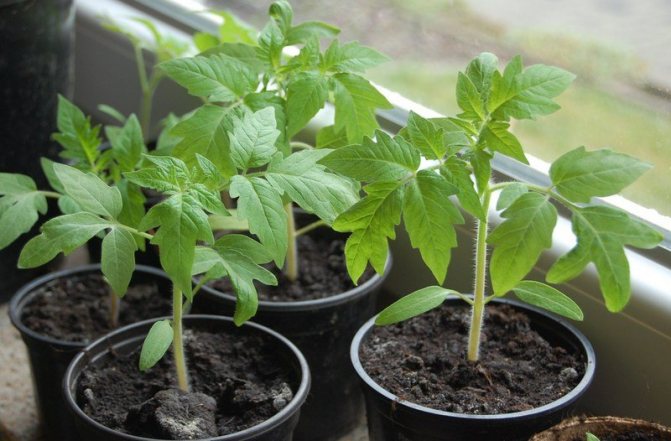

It is imperative to grow seedlings of this tomato in separate pots, and not small ones.
You can sow seeds in a small box, and you should dive the seedlings straight into large pots with a capacity of about a liter. If you save on container size, a second transplant may be required closer to May: tomato seedlings of this variety grows very large, massive and root system. Do seedlings need feeding? For many varieties, they try to do without this so that the seedlings do not pamper. Jubilee Tarasenko requires a lot of nutrients, so most likely it will not be possible to do without feeding.
Seedlings are planted at the usual time, but not in the same way as most tomatoes. For liana-like varieties, they dig a whole planting hole, up to a bucket in volume. At least half a bucket of humus and a good handful of ash are brought into it, mixed well. At the same time, the roots should not be buried deeply; if the seedlings are overgrown, it is better to plant them obliquely. The scheme is free, but the distance between the bushes should be at least 70 cm. The construction of the trellis is mandatory: ordinary stakes are indispensable. You have to tie up both the stems and each fruit cluster, and not in one place. Often props or even wooden boxes are placed under the brushes. Some gardeners arrange the main stems of the plant horizontally, tying them in several places to a wire.
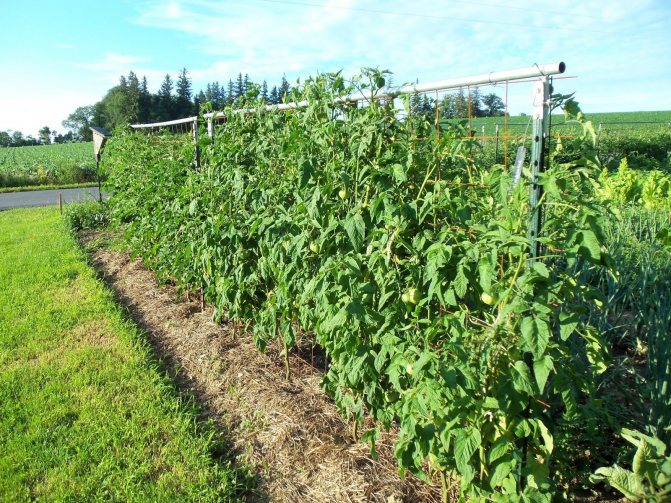

To grow liana-shaped tomatoes, you need trellises made of very durable materials.
A lot of water is required for irrigation: before the fruits ripen - at least a bucket per week, then watering is greatly reduced. Top dressing is carried out every two weeks. The bush is led into one or two stems, the emerging stepchildren are constantly breaking out.Tear off the leaves as they turn yellow. The growth of the bush is limited by pinching the stems at a certain height or after four or five brushes, depending on the climate of the region.
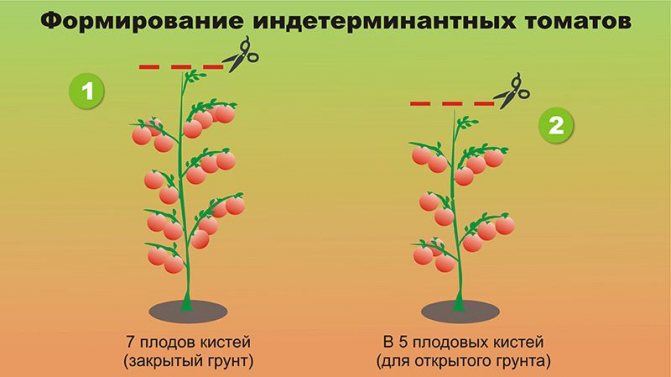

All the fruits will still not be able to grow, so the stems are cut at a certain height
In addition to removing stepchildren, it is necessary to normalize the number of flowers, removing the smallest or later ones. No more than 30 fruits can be left in each brush. Tomatoes should not be picked completely ripe: to continue fruiting, they are plucked in a state of blanche ripeness. They ripen well when stored.
How to grow seedlings
Sowing seeds for seedlings begins 2 months before planting in the ground. Gardeners can harvest seed from their own crop, as it is a varietal crop, which means that genetic information is stored for years.
Seed preparation
Self-collected grains are disinfected and prepared for sowing. Disinfection takes place in a weak solution of potassium permanganate for 20-30 minutes. Then they are washed and dried.
To improve germination, the grains are soaked in a growth stimulator for 11 hours. As a stimulant, in addition to special preparations, melt or ordinary boiled water is used.
Reference! Of the growth stimulants, the most commonly used are "Epin", "Kornevin" and "Immunocytofit".
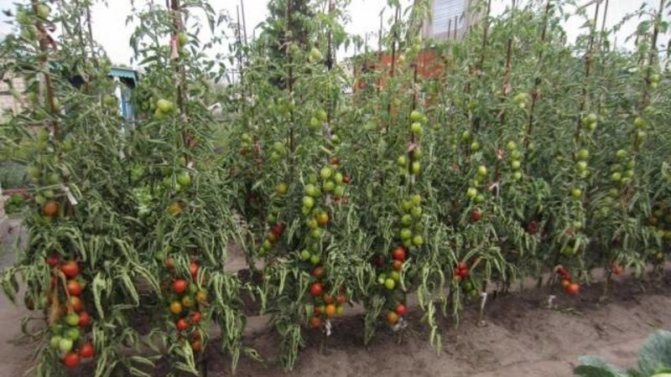

Capacity and soil
The soil is prepared from garden soil and humus in equal amounts. A little sawdust or washed river sand is added as a baking powder. The resulting mixture is spilled with a hot solution of dark potassium permanganate or steamed in an oven at a temperature of 60 ° C for 10 minutes. The cooled soil is laid out in planting containers, filling them halfway. This makes it possible to add soil to the containers as the seedlings grow, thereby providing additional nutrition.
It can be planted in a common wooden box and in an individual container, at the bottom of which drainage holes are preliminarily made. When planted in separate containers, further care of tomatoes is minimized.
Reference! Drainage holes at the bottom of the planting containers do not allow moisture to stagnate, which prevents the development of a disease such as black leg.
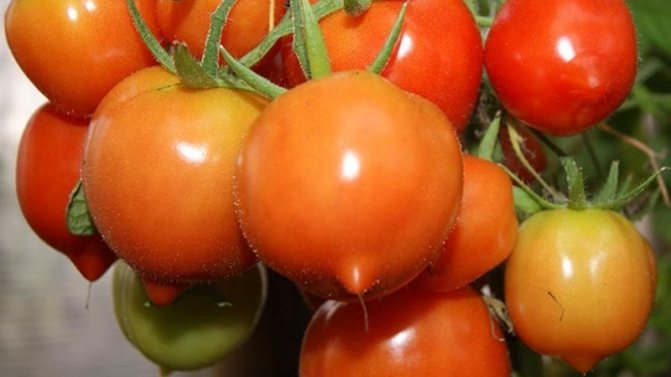

Sowing
Seeds are sown to a depth of 2 cm with a distance of 3 cm from each other. Sprinkle with earth on top, slightly compact and cover the containers with foil to create a greenhouse effect. The landing containers are left in a bright and warm room at a temperature of 24-25 ° C. periodically, the film is removed for ventilation and, as the upper soil layer dries up, it is moistened with warm, settled water using a spray bottle.
Seedling care
When shoots appear, the film is removed and the containers are rearranged on the windowsill. Since the seedlings are prone to stretching, it is necessary to provide a sufficient amount of light for a long time. During the first days experienced gardeners supplement plantings with electric fluorescent lamps around the clock.
Pour with moderately warm, settled water along the edge of the containers using a shallow watering can. After watering, the soil is loosened with a wooden stick or ordinary fork.
Reference! Loosening is carried out superficially so as not to touch the young roots.
When 2 true leaves appear, the seedlings are dived, seated in separate containers. During the pick, strong and healthy plants are left for further development. After the pick, the growth and development of seedlings is more intensive.
Reference! When breeding seedlings in peat containers, picking is not required.
Hardening begins 2 weeks before planting in the ground. For this, the seedlings are taken out into the open air for 1 hour in the daytime. The time interval is gradually increased to 12 hours. Simultaneously with the daytime hardening, the nighttime room temperature is reduced to 13 ° C.
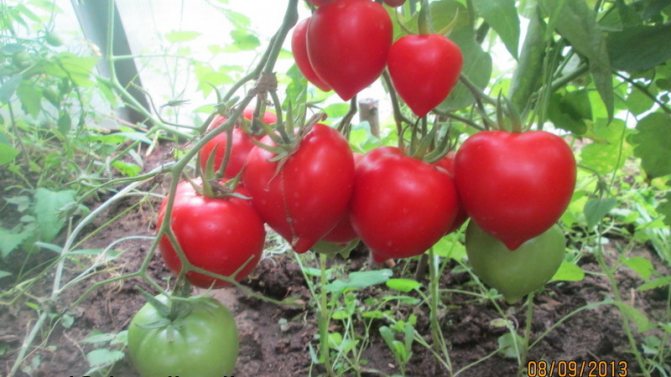

Reviews about tomato Yubileiny Tarasenko
I drove the stakes into which the hooks were screwed between the bushes, to these stakes on the hooks and tied the brushes, they stood for me like on struts. There was a hassle, but the harvest was very good. large.
Lyubasha
It is precisely Tarasenok that I specially grow for cold salting, the most delicious are obtained. Many other varieties are salted, and these are tasty after a year. This year, a few of them got into pickled ones, also excellent.
Salih
I also refined myself, while these brushes were tied up with flowering and small fruits, I planted it for the first time, I did not even imagine that such a monster would turn out, but it is late, all the bushes around are already removed, like the fruits of Yu.T. began to fill up - tie it up as you want, everything is empty.
Lena
I planted Jubilee Tarasenko in 2012. The pack says that this is a grade. There are really a lot of fruits. The nose was poorly expressed, at least not on all fruits. The tomato is very tasty, though the skin was strong. But the red tomatoes hung on the bushes for a very long time - to the envy of the neighbors.
Beloch
Jubilee Tarasenko really like it - fruitful, huge brushes, good in salting. Grew up in OG, covered with covering material in the spring.
Rina


